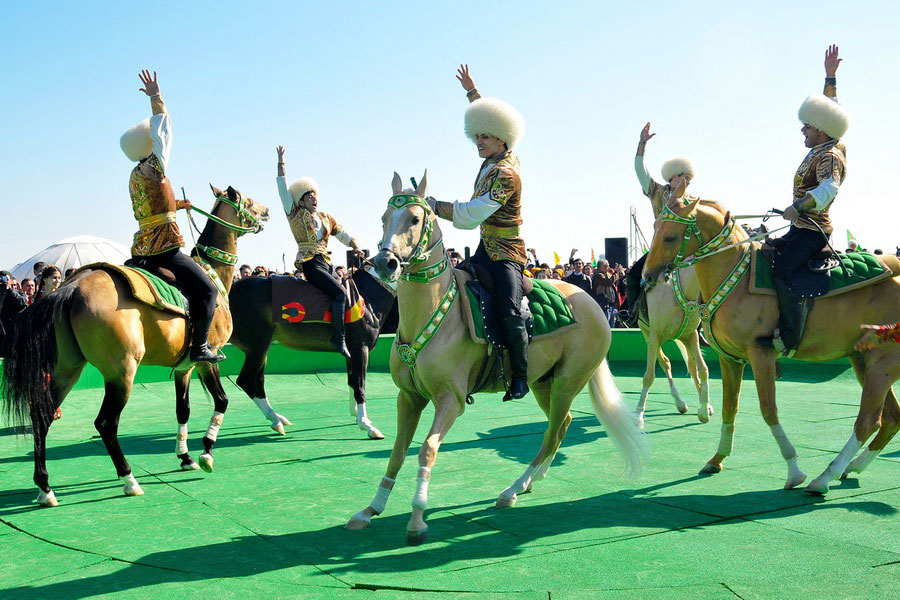
Turkmen Akhal-Teke horses are a cultural treasure and historic symbol of the tribal, desert nomads of Turkmenistan. Among the oldest and rarest breeds in the world today, they are highly prized internationally for their intelligence, endurance and speed.
According to researchers, Akhal-Teke horses are descended from the now extinct Nisean horses which were once bred in Media (modern-day Iran). The Nisean horse likely was the ancestor of the Turkoman horse, the predecessor of the Akhal-Teke stallions now prevalent in Turkmenistan. Turkoman horses likely found their way to Turkey and Europe, where they spawned the purebred English breed, a symbol of luxury and high society in the historic Western world. At the end of the 19th century, Turkmen horses began to be known as "Akhal-Teke" in reference to a desert oasis called Akhal and a local tribe known as the Teke.
In the past, the nomadic Turkmen people paid little attention to the concept of a purebred horse, being more concerned with the strength and endurance of the animal than with its pedigree. Raising and breeding the Akhal-Teke horse proved relatively easy despite the arid climate and limited pastureland in Turkmenistan, and these animals soon became the tireless helpers of the local population. Turkmen soldiers likewise found reliable friends in the Akhal-Teke breed, who are known to have saved the life of their rider on many occasions. In time, the possession of an Akhal-Teke horse came to be viewed as a status symbol for the rich and noble. Although the Turkmen people have now been settled in cities and villages for two centuries, a love and respect for horses remains in their blood.
As it is believed that the Akhal-Teke stallion is a one-owner horse, it is not customary to give, sell or exchange horses in Turkmenistan. The rider and his mount form an inseparable team and only part in death. In order to raise such loyal horses, meticulous stall maintenance and care is needed. Traditionally, Akhal-Teke horses lived long lives and often accompanied their master on his final journey.
Akhal-Teke horses amaze everyone with their grandeur and noble beauty. Graceful, thin-legged and beautiful, horses of the Akhal-Teke breed look like statuettes come to life. They have very thin skin and a shiny coat with a silver or gold sheen. Horse breeders describe the Akhal-Teke as strong, agile, temperamental, curious and efficient. Indeed, this horse commands respect with its intelligence, endurance and speed, demonstrating to its owner with every fiber of its being that it should be treated with honor and dignity. The Turkmen, for their part, have long mastered the art of taming the proud temper of the Akhal-Teke horse.
The incredible endurance of this desert horse breed was demonstrated on a race from Ashgabat to Moscow in 1935 in which 17 riders from Turkmenistan covered more than 4,000 kilometers in just 84 days. For more than 300 kilometers of the race, they passed through the Karakum Desert without stopping at a single oases. Exactly 10 years later, Soviet Marshal Georgy Zhukov hosted the Victory Parade on Moscow’s Red Square while sitting on a stately Turkmen horse of the Akhal-Teke breed.
In the 20th century, Akhal-Teke horses from Turkmenistan began participating in international equestrian exhibitions in Europe and Russia, evoking special admiration from the jury. According to an oft-told story, in the 1960s Nikita Khrushchev gifted Queen Elizabeth II an Akhal-Teke horse. The queen’s chief equerry thought that the horse had been painted with gold dye, so he ordered it to be washed. One can imagine his surprise when the stallion only shone with renewed vigor after bathing!
Turkmen Akhal-Teke horses began to increase in popularity around the world only after Turkmenistan gained independence in 1991. Today, it is one of the rarest and most highly prized breeds in the world. Considered a cultural treasure, its image has even been placed on Turkmenistan’s national emblem as a symbol of freedom.
When visiting Turkmenistan, you can visit stables near Ashgabat to take riding lessons and admire these luxurious animals. Or, consider participating in Day of the Turkmen Horse, celebrated every year on the last Sunday of April with fairs, exhibitions, beauty contests for the horses and, of course, speed races.
Today, the gene pool of Turkmen Akhal-Teke horses is being cultivated and carefully preserved for future generations of Turkmen who will hopefully inherit a love for this proud and competent steed.

